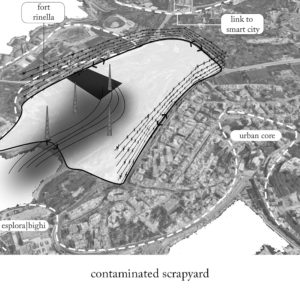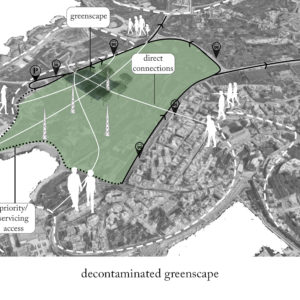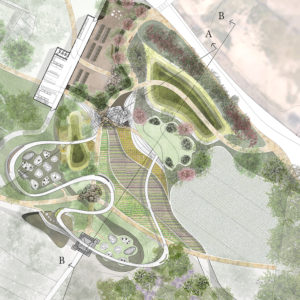The aim of this project was to detoxify part of the Rinella Valley, currrently being used as a scrapyard. Following careful understanding of present, toxic conditions, sensitive measures to decontaminate the area such as phytoremediation strive to transform the area into a demonstrative greenscape, incorporating composting activities, swales, greenhouses and an overall interactive landscape for all demographics.
The project aimed at revitalizing a piece of land sitting in the middle of the Rinella Valley in Kalkara that had been lost to a scrapyard, at the detriment of negligence and seepage of heavy metal contaminants. The goal was to rehabilitate the site from a contaminating brownfield to a decontaminated greenscape by injecting new life, increasing accessibility, re-adapting existing structures, and introducing paths to raise awareness of the valley’s rich biodiversity.
Following extensive research, the detoxification process was divided into three phases in which environmental remediation employed several strategies, primarily phytoremediation, which is the extraction of toxins using living plants, as well as composting, the nutrients of which balance out the soil. Furthermore, to encourage people to use the space, a composting facility was purposely designed as a demonstrative landscape whereby visitors, families and students are able interact with and learn from.
Most of the components, from the paving slabs to the greenhouse, adopted a natural Voronoi tessellation pattern, while the choice of material blended organically with the surroundings to minimize human impact. Using a vast palette, the vegetation was carefully allocated to exploit the microclimate of the area and restore the site back to its natural state following the scrapyards negative impact on the environment.
Environmental Benefits:- Improve air quality
- Meeting targets to reduce emissions
- Sustainable water management
- Habitats for ecosystems & biodiversity
- Improve quality of life (recreation and well-being)
- Safety & security in public urban areas
- Support social interaction & cohesion
- Mental health through access to nature
- Physical health through active lifestyles
- Reduce flooding impacts
- Opportunities for local food production
- Enhance productivity










